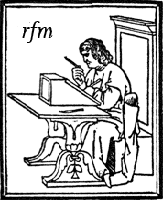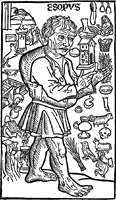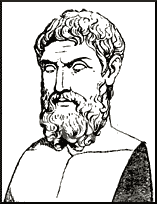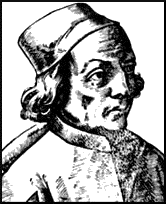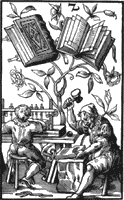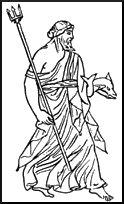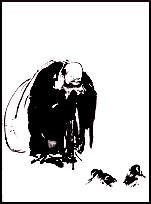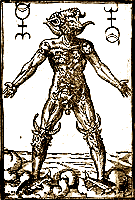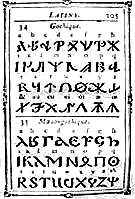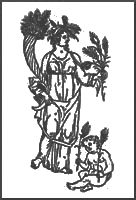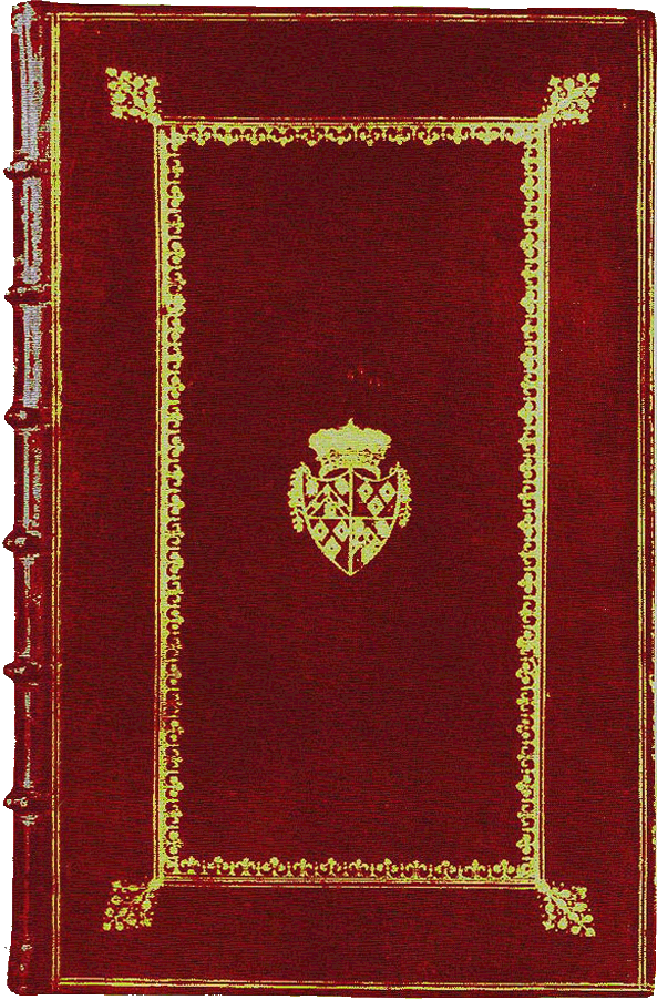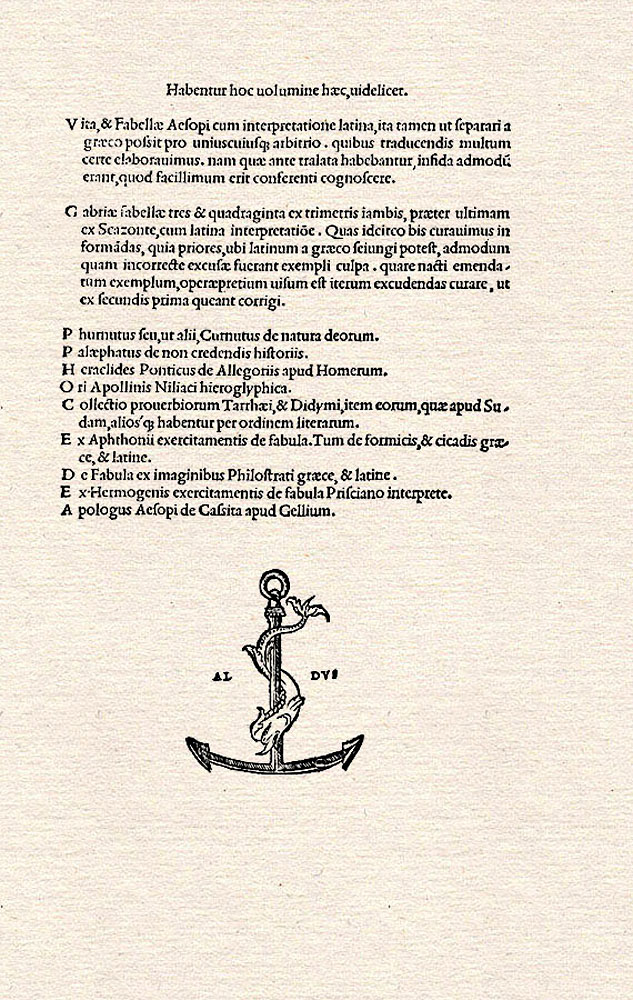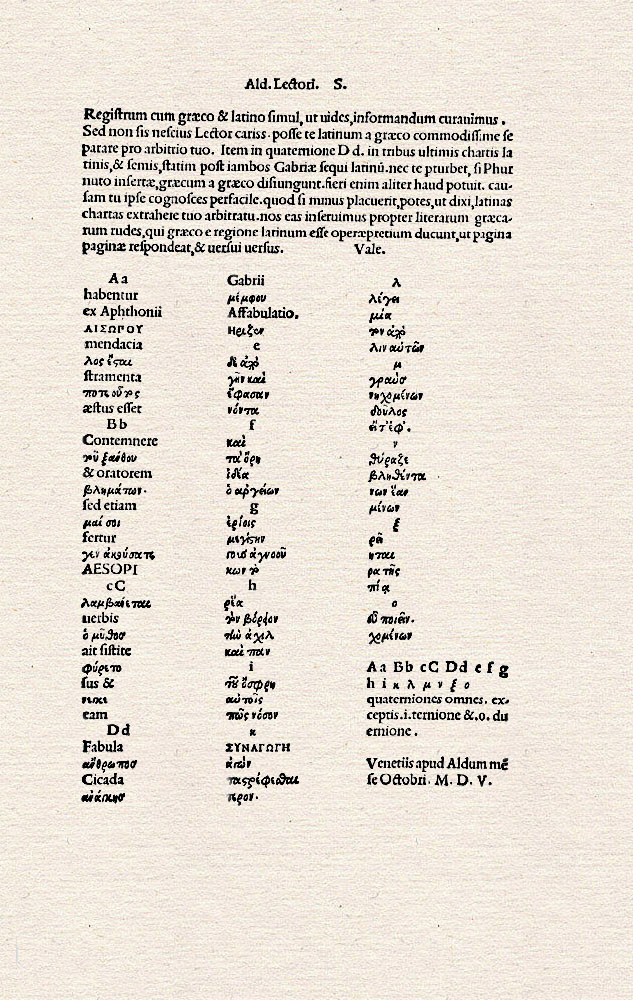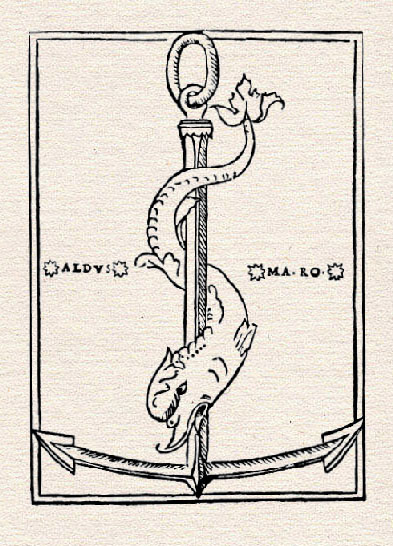Αἴσωπος, Aesopus: Fabulae — Ὡϱαπόλλων, Horapollon: Hieroglyphica ...
Aesopus Fabulae / Horapollon
Aesops Fabeln mit der Editio princeps von Horapollon
Αἴσωπος, Aesop & Ὡϱαπόλλων, Horapollon:
Habentur hoc uolumine hæc, uidelicet. || Vita, & Fabellæ Aeſopi cum interpretatione latina, ita tamen ut ſeparari a | græco poſsit pro uniuscuiusq3 arbitrio. quibus traducendis multum | certe elaborauimus. nam quæ ante tralata habebantur, infida admodū | erant, quod facillimum erit conferenti cognoſcere. || Gabriæ fabellæ tres & quadraginta ex trimetris iambis, præter ultimam | ex Scazonte, cum latina interpretatiōe. Quas idcirco bis curauimus in | formādas, quia priores, ubi latinum a græco ſeiungi poteſt, admodum | quam incorrecte excuſæ fuerant exempli culpa. quare nacti emenda-|tum exemplum, operæpretium uiſum eſt iterum excudendas curare, ut | ex ſecundis prima queant corrigi. || Phunutus seu, ut alii, Curnutus de natura deorum. | Palæphatus de non credendis hiſtoriis. | Heraclidis Ponticus de Allegoriis apud Homerum. | Ori Apollinis Niliaci hieroglyphica. | Collectio prouerbiorum Tarrhæi, & Didymi, item eorum, quæ apud Su-|dam, alios’q3 habentur per ordinem literarum. | Ex Aphthonii exercitamentis de fabula. Tum de formicis, & cicadis græ-|ce, & latine. | De Fabula ex imaginibus Philoſtrati græce, & latine. | Ex Hermogenis exercitamentis de fabula Priſciano interprete. | Apologus Aeſopi de Caſsita apud Gellium. || Signet 3.
Kolophon fol. o4r: Venetiis apud Aldum mē|ſe Octobri M.D.V. Verso: Folio-Signet f1.
Venedig: Aldus Manutius, 1505.
Quarto. 266 × 164 mm. [13] Bll., Ss. 27-142 (Pagination springt von 128 auf 131); 172 Spp.; [1] Bl.; [34] (statt 36) Bll. – Lagenkollation: [Gr. Text:] a-h8, i6, κ-ξ8, ο4; [Lat. Text:] A6 (statt 8; ohne A4 & 5), B10, C8, D10.
Inhalt: fol. a1r: Titel — fol. a1v: Aphthonius: Exercitamenta, Fabula; Philostratus: Imagines et fabulae — fol. A1v: Maximus Planudes: Aesopi vita — fol. A4r: Hermogenes: Exercitamenta, Prisciano interprete; Aulus Gellius: Apologus Aesopi — fol. B4v: Aesopus: Fabulae — fol. d2v: Babrius: Tetrasticha — fol. D6r: Cornutus: De natura deorum — fol. f1r: Palaephatus: De non credendis historiis — fol. f8v: Heraclides Ponticus: De allegoriis apud Homerum — fol. h5r: Horapollo: Hieroglyphica — fol. ϰ1r: Tarrhaeus et Didymus: Collectio proverbiorum — fol. o4r: Lagenverzeichnis, Kolophon — fol. o4v: Signet.
Dunkelrotes englisches Maroquin des späten 18. Jh. auf sechs erhabenen Bünden mit Rückenvergoldung aus fleuralen Stempeln in Doppelrahmen, im zweiten Feld Titel und Drucker; auf den Deckeln je ein äußerer Rahmen aus zwei vergoldeten Linien sowie ein innerer aus ebensolchen und einer nach innen weisenden Rolle aus stilisierten Blüten und Lilien, von dessen Ecken nach außen weisend vier fleurale Stempel; Steh- und Innenkantenvergoldung, handgestochene Kapitale in Hellgrün/Weiß, Goldschnitt; Vorsätze aus Schneckenmarmor; das Wappensupralibris des 3. Duke of Roxburghe auf die Deckelmitten geprägt.
Die einzige Ausgabe des Aesopschen Textes bei Aldus, auf festes, beinahe glattes Papier, bei dem die Stege kaum mehr sichtbar sind, in der dritten aldinischen Type gedruckt und mit seinem abwechselungsreichen Schriftbild als eines der schönsten Bücher angesehen, die dieser je schuf. – Cornutus (1. Jh.) verfaßte eine Allegorese der Mythen nach den Grundsätzen der Stoa; dies ist neben der Schrift von Salustios die einzige erhaltene griechische Theologie.
¶ Horapollons Schrift auf pp. 121-142: „Die Gelehrten sind uneinig, wer dieser Horus eigentlich gewesen. ...(er) hat in egyptischer Sprache ein Buch verfertiget, das Hieroglyphica betitelt ist, und worin die heiligen Bilder erkläret werden, wodurch die Egyptier die Dinge bezeichneten. Aus diesem Buche hat ein gewisser, Philippus, von dem ausser dem blossen Namen weiter nichts bekant ist, nicht so wol eine getreue Uebersezzung, als einen Auszug in einer freien Umschreibung in griechischer Sprache gemacht, der noch übrig ist,...“ (Hamberger I,45)
¶ Das Register gibt genaue Anweisungen, wie der Buchbinder die Blätter der ersten vier Lagen zusammenzulegen habe, damit griechischer und lateinischer Text sich je gegenüberstehen - doch hier, wie oft sind die beiden Teile getrennt nacheinander gebunden, welches offensichtlich beim Neubinden im 18. Jh. geschehen ist, wo wohl auch die beiden nun fehlenden Blatt nicht mitgeheftet worden sind, was in den angeführten Auktionskatalogen unbemerkt blieb. Davor hatte dies Exemplar die Idealkollation, wie aus den übereinstimmenden kleinen Wurmgängen am Rand von fol. a1 und fol. A1 zu erschließen ist.
¶ Provenienz: 1. Besitzeintrag auf Titel: „(...) 1588. Pierre delongueil Coner d. l. Cour. – 2. John Ker, third Duke of Roxburghe (1740-1804), verkauft als n° 6715 während der Auktion seiner Bibliothek am 18. Mai 1812 für £ 9-0-0 an (3.) Booth, danach an den (4.) zweiten Earl of Powis (1785-1848), wo es in dessen Aldinenauktion bei Sotheby als n° 418 am 22. März 1923 verkauft wurde. – 5. Quaritch mit einem Eintrag von 3.6.1926, der das Fehlen der beiden Bll. erwähnt. Ad 2.: Auf der erwähnten Auktion des Jahres 1812, die eine Caxton-Sammlung und andere wertvolle Drucke enthielt, wurde das Exemplar von Valdarfers Boccaccio, 1471, das wohl der Vater für £105 angekauft hatte, dem Marquis von Blandford für £2260 verkauft. Um dies Ereignis gebührend zu feiern, versammelten sich unter dem Vorsitz Lord Spencer’s die wichtigsten Bibliophilen des Tages und speisten zusammen in der St. Alban’s Tavern. Man beschloß bei dieser Gelegenheit, den Roxburghe Club zu gründen, der damals aus 24 Mitgliedern bestand mit Th. F. Dibdin als erstem Sekretär.
Renouard 49,6 – Adams A 278 – Didot: A.M. et l’Hellenisme à Venise. p. 281: « ... et d’autres ècrits parmi lesquels le texte grec de Hieroglyphica de Horus Apollo, donné ici pour la première fois. » – Ebert 214 – Ebert 10109 zu Horapollo: „Zuerst bei Aesopus. Ven., Ald., 1505, f.“ – Schück 42,6 – Fock: Pahlen p. 181 (Anhang, nicht in der Sammlung Pahlen!) – Isaac 12811 – Bibliographien. — Die Abbildungen stammen aus meinem Katalog 7, wurden bearbeitet und geben nicht den originalen Zustand wieder!
Renouard
 ans cette rare et belle édition, la version latine des Fables est intercalée dans le grec, de manière à pouvoir ètre ôtée à volonté, comme dans la Grammaire de Lascaris, Gregor. Naz. Carmina, etc. Aussi des exemplaires dépourvus de cette version latine, ont donné lieu à annoncer deux éditions différentes; l’une en grec seul, l’autre en grec et latin; tandis que véritablement il n’y en a qu’une. Le titre, indiquant une double impression des Fables de Gabrias, a aussi fait croire qu’il y avoit deux sortes d’exemplaires, les uns entièrement de première édition, les autres, avec ces Fables réimprimées sur des feuillets substitués aux anciens: c’est ce que pense Harles, Bibl. gr. tome premier, p. 642 : Foliis quibusdam er alio codice curatius correctis, prioribus ut plurimunersectis. C’est encore une erreur. Les Fables de Gabrias, imprimées d’abord à la suite de celles d’Esope, occupent, dans le grec, les pages 52 à 58. La version latine qui est en regard n’est point chiffrée : la seconde impression se trouve, en grec et en latin, non pas à la suite, mais en remontant dans le milieu de la version latine, dont elle occupe le dedans des feuillets B5, C4, D5, et continue sur les sept dernières pages du cabier D de la version latine, qui sont intercalées dans les feuillets grecs de Phurnutus. Alde aura d’abord imprimé son grec; et reconnoissant le Gabrias incorrect, pour ne pas recommencer, il aura préféré le répéter en grec et latin sur les feuillets que lui laissoit blancs l’arrangement qu’il donnoit à sa version latine.
ans cette rare et belle édition, la version latine des Fables est intercalée dans le grec, de manière à pouvoir ètre ôtée à volonté, comme dans la Grammaire de Lascaris, Gregor. Naz. Carmina, etc. Aussi des exemplaires dépourvus de cette version latine, ont donné lieu à annoncer deux éditions différentes; l’une en grec seul, l’autre en grec et latin; tandis que véritablement il n’y en a qu’une. Le titre, indiquant une double impression des Fables de Gabrias, a aussi fait croire qu’il y avoit deux sortes d’exemplaires, les uns entièrement de première édition, les autres, avec ces Fables réimprimées sur des feuillets substitués aux anciens: c’est ce que pense Harles, Bibl. gr. tome premier, p. 642 : Foliis quibusdam er alio codice curatius correctis, prioribus ut plurimunersectis. C’est encore une erreur. Les Fables de Gabrias, imprimées d’abord à la suite de celles d’Esope, occupent, dans le grec, les pages 52 à 58. La version latine qui est en regard n’est point chiffrée : la seconde impression se trouve, en grec et en latin, non pas à la suite, mais en remontant dans le milieu de la version latine, dont elle occupe le dedans des feuillets B5, C4, D5, et continue sur les sept dernières pages du cabier D de la version latine, qui sont intercalées dans les feuillets grecs de Phurnutus. Alde aura d’abord imprimé son grec; et reconnoissant le Gabrias incorrect, pour ne pas recommencer, il aura préféré le répéter en grec et latin sur les feuillets que lui laissoit blancs l’arrangement qu’il donnoit à sa version latine.
Une description détaillée allongeroit inutilement cette notice, déjà assez étendue. Il suffira de faire ici remarquer qu’un exemplaire est imparfait s’il n’a pas les Fables en latin; que la réimpression de Gabrias, ayant le grec mèlé avec le latin, y est nécessairement quand la version latine ne manque pas; que le volume a en totalité 150 feuillets, dont le grec est chiffré à commencer à la page 17 jusqu’à 142, mais entremèlé des feuillets de version latine, qui ne le sont pas; que, par erreur de chifires, il n’y a pas de pages 129-130; et enfin, qu’après la page 142 le reste du volume est à deux colonnes, et chiffré par colonnes, dont la dernière, cotée 172, est suivie d’un dernier feuillet contenant la date, un avis d’Alde, et un registre fort exact, avec lequel on peut facilement collationner le volume. L’ancre Aldine est sur la première et sur la dernière page.
Les deux plus beaux exemplaires que j’aie vus de ce rare volume sont, 1° celui de Remondini, magnifiquement relié par Lewis, et qui après avoir passé dans les mains de plusieurs propriétaires, est actuellement dans la belle collection de M. Beckford; 2° celui de Meerman, peut-être plus beau encore, et qui est en ma possession.
— Antoine Auguste Renouard: Annales de l’imprimerie des Alde, histoire des trois Manuce et de leurs éditions. Troisième édition. Paris: Jules Renouard, 1834. p. 50.
Didot
 n 1505, parut un seul volume grec, format in folio : Ésope, suivi de Gabrias et d’autres écrits parmi lesquels le texte grec de Hieroglyphica de Horus Apollo, donné ici pour la première fois. Alde dit en avoir beaucoup amélioré la traduction, ce dont il est facile de s’assurer si on la compare avec les précédentes ; quelques exemplaires ont la traduction latine intercalée dans le texte, à d’autres elle manque ; ce qui a fait croire à deux éditions. Cependant Alde,dans un avis placé en tête et à la fin, annonce qu’il a imprimé le texte et la traduction de manière qu’on pût les séparer, et former au besoin deux exemplaires, l’un grec, l’autre latin.
n 1505, parut un seul volume grec, format in folio : Ésope, suivi de Gabrias et d’autres écrits parmi lesquels le texte grec de Hieroglyphica de Horus Apollo, donné ici pour la première fois. Alde dit en avoir beaucoup amélioré la traduction, ce dont il est facile de s’assurer si on la compare avec les précédentes ; quelques exemplaires ont la traduction latine intercalée dans le texte, à d’autres elle manque ; ce qui a fait croire à deux éditions. Cependant Alde,dans un avis placé en tête et à la fin, annonce qu’il a imprimé le texte et la traduction de manière qu’on pût les séparer, et former au besoin deux exemplaires, l’un grec, l’autre latin.
— Ambroise Firmin Didot: Alde Manuce et l’Hellénisme à Venise. Orné de quatre portraits et d’un fac-simile. Hellénisme dans l’Occident. Isabelle d’Este, Marquise de Mantoue. Correspondance inédite des réfugiés grecs en Italie. Zacharias Calliergi et les calligraphes crétois. Premières impressions greques, etc. Paris: Ambroise Firmin-Didot, 1875. pp. 281-282.
Anmerkung
Aus dem Katalog eines nicht unberühmten englischen Antiquariates erworben; man vertröstete mich, es werde noch ein paar Tage dauern, das Buch befinde sich zum Restaurieren bei einem Buchbinder. Als es dann in Berlin anlangte, und ich es beim Zoll abholen durfte, entdeckte ich nur mit Lupe und gutem Licht die Ränder des alten Bezuges an den Gelenken. Ein Meisterwerk.
Selbstverständlich nicht in den deutschsprachigen Raum verkauft.
Aesop
Ἀνὴϱ πένταϑλος ἐπ’ ἀνανδϱίᾳ ἑϰάστοτε ὑπὸ τῶν πολιτῶν ὀνειδιζόμενος ἀποδημήσας ποτὲ ϰαὶ μετὰ χϱόνον ἐπανελϑὼν ἀλαζονευόμενος ἔλεγεν, ὡς πολλὰ μὲν ϰαὶ ἐν ἄλλαις πόλεσιν ἀνδϱαγαϑήσας ἐν τῇ Ῥόδῳ τοιοῦτον ἥλατο πήδημα ὡς μηδένα τῶν Ὀλυμπιονιϰῶν ἐφιϰέσϑαι. ϰαὶ τοῦτοῦ μάϱτυϱας ἔφη παϱέξεσϑαι τοὺς παϱατετυχηϰότας, ἂν ἄϱα ποτὲ ἐπιδημήσωσι. τῶν δὲ παϱόντων τις ὑποτυχὼν ἔφη πϱὸς αὐτόν· „ἀλλ’, ὦ οὗτος, εἰ τοῦτο ἀληϑές ἐστιν, οὐδὲν δεῖ σοι μαϱτύϱων· αὐτοῦ γὰϱ Ῥόδος ϰαὶ πήδημα.“ ὁ λόγος δηλοῖ, ὅτι ὧν πϱόχειϱος ἡ δι’ ἔϱγων πεῖϱα, πεϱὶ τοῦτων πᾶς λόγος πεϱιττός ἐστιν.
Ein Fünfkämpfer wurde stets seiner Untüchtigkeit wegen von seinen Mitbürgern kritisiert. Er begab sich außer Landes, kehrte nach einiger Zeit zurück und prahlte, er habe auch sonst oft, besonders aber auf Rhodos einen Sprung dargeboten, den kein Olympionike erreichen könne. Als Zeugen, sagte er, werde er jene Leute aufbieten, die dabei waren, sobald sie ins Land kämen. Aber ein Anwesender fiel ein und sprach zu ihm: „Hör mal! Wenn das wahr ist, brauchst du keine Zeugen, denn hier ist Rhodos, springe hier!“ Die Fabel zeigt, daß sich für das, was sich unmittelbar durch die Tat überprüfen läßt, jedes Wort erübrigt.
Ὡϱαπόλλων — Horapollon
Βιβλίον πϱῶτον — Book I
1. Πῶς αἰῶνα σημαίνουσιν — How they denote eternity
Αἰῶνα σημαίνοντες, ἥλιον ϰαὶ σελήνην γϱάφoυσι, διὰ τὸ αἰώνια εἶναι στοιχεῖα. αἰῶνα δ’ ἑτέϱως γϱάψαι βουλόμενοι, ὄφιν ζωγϱαφοῦσιν, ἔχοντα τῆν οὐϱάν ὑπὸ τὸ λοιπὸν σῶμα ϰϱυπτομένην, ὃν ϰαλοῦσιν Αἰγύπτιοι οὐϱαῖον, ὅ ἐστιν ἑλληνιστὶ βασιλίσϰον, ὅνπεϱ χϱυσοῦν ποιoῦντες, ϑεοῖς πεϱιτιϑέασιν. αἰῶνα δὲ λέγουσιν Αἰγύπτιοι διὰ τοῦδε τοῦ ζώου δηλοῦσϑαι, ἐπειδὴ τϱιῶν γενῶν ὄφεων ϰαϑεστώτων, τὰ μέν λοιπὰ ϑνητὰ ὑπάϱχει, τοῦτο δὲ μόνον ἀϑάνατον, ὃ ϰαὶ πϱοσφυσῆσαν ἑτέϱῳ παντὶ ζώῳ, δίχα ϰαὶ τοῦ δαϰεῖν, ἀναιϱεῖ· ὅϑεν ἐπειδὴ δοϰεῖ ζωῆς ϰαὶ ϑανάτου ϰυϱιεύειν, διὰ τοῦτο αὐτὸν ἐπὶ τῆς ϰεφαλῆς τῶν ϑεῶν ἐπιτιϑέασιν.
To denote Eternity they depict the Sun and Moon, because their elements are eternal. But when they would represent Eternity differently, they delineate a Serpent with its tail covered by the rest of its body: the Egyptians call this Ouraius, which in the Greek language signifies Basilisk: And they place golden figures of it round the Gods. The Egyptians say that Eternity is represented by this animal; because of the three existing species of serpents, the others are mortal, but this alone is immortal; and because it destroys any other animal by merely breathing upon it even without biting. And hence, inasmuch as it thus appears to have power over life and death, they place it upon the head of the Gods.
2. Πῶς ϰόσμον — How the universe
Κόσμον βουλόμενοι γϱάψαι, ὄφιν ζωγϱαφοῦσι τὴν ἑαυτοῦ ἐσϑίοντα οὐϱάν, ἐστιγμένον φολίσι ποιϰίλαις, διὰ μὲν τῶν φολίδων αἰνιττόμενοι τοὺς ἐν τῷ ϰόσμῳ ἀστέϱας. βαϱύτατον δὲ τὸ ζῶον ϰαϑάπεϱ ϰαὶ ἡ γῆ, λειότατον δὲ ὥσπεϱ ὕδωϱ· ϰαϑ’ ἕϰαστον δὲ ἐνιαυτὸν τὸ γῆϱας ἀφεὶς, ἀποδύεται, ϰαϑ’ ὃ ϰαὶ ὁ ἐν τῷ ϰόσμῳ ἐνιαύσιος χϱόνος, ἐναλλαγὴν ποιούμενος, νεάζει· τὸ δὲ ὡς τϱοφῇ χϱῆσϑαι τῷ ἑαυτοῦ σώματι σημαίνει τὸ πάντα ὅσα ἐϰ τῆς ϑείας πϱονοίας ἐν τῷ ϰόσμῳ γεννᾶται, ταῦτα πάλιν ϰαὶ τὴν μείωσιν εἰς αὐτὸν λαμβάνειν.
When they would represent the universe, they delineate a Serpent bespeckled with variegated scales, devouring its own tail; by the scales intimating the stars in the universe. The animal is also extremely heavy, as is the earth, and extremely slippery, like the water: moreover, it every year puts off its old age with its skin, as in the universe the annual period effects a corresponding change, and becomes renovated. And the making use of its own body for food implies, that all things whatsoever, that are generated by divine providence in the world, undergo a corruption into it again.
3. Πῶς ἐνιαυτόν — How a year
Ἐνιαυτόν δὲ βουλόμενοι δηλῶσαι, Ἶσιν, τουτέστι γυναῖϰα ζωγϱαφοῦσι, τῷ δὲ αὐτῷ ϰαὶ τὴν ϑεόν σημαίνουσιν. Ἴσις δὲ παϱ’ αὐτοῖς ἐστὶν ἀστὴϱ, αἰγυπτιστὶ ϰαλούμενος Σῶϑις, ἑλληνιστὶ δὲ Ἀστϱοϰύων, ὃς ϰαὶ δοϰεῖ βασιλεύειν τῶν λοιπῶν ἀστέϱων, ὁτὲ μὲν μείζων, ὁτὲ δὲ ἥσσων ἀνατέλλων· ϰαὶ ὁτὲ μὲν λαμπϱότεϱος, ἐσϑ’ ὁτὲ δ’ οὐχ οὕτως· ἔτι δὲ ϰαὶ, διότι ϰατὰ τὴν τούτου τοῦ ἄστϱου ἀνατολὴν σημειούμεϑα πεϱὶ πάντων τῶν ἐν τῷ ἐνιαυτῷ μελλόντων τελεῖσϑαι, διόπεϱ οὐϰ ἀλόγως τὸν ἐνιαυτὸν Ἴσιν λέγουσιν. ϰαὶ ἑτέϱως δὲ ἐνιαυτὸν γϱάφοντες, φοίνιϰα ζωγϱαφοῦσι, διὰ τὸ δένδϱον τοῦτο μόνον τῶν ἄλλων ϰατὰ τὴν ἀνατολὴν τῆς σελήνης μίαν βάϊν γεννᾶν, ὡς ἐν ταῖς δώδεϰα βάϊσιν ἐνιαυτὸν ἀπαϱτίζεσϑαι.
When they would represent a year, they delineate Isis, i. e. a woman. By the same symbol they also represent the goddess. Now Isis is with them a star, called in Egyptian, Sothis, but in Greek Astrocyon, [the Dog-star]; which seems also to preside over the other stars, inasmuch as it sometimes rises greater, and at other times less; sometimes brighter, and at other times not so; and moreover, because according to the rising of this star we shew all the events of the ensuing year: therefore not without reason do they call the year Isis. When they would represent the year otherwise, they delineate a palm tree [branch], because of all others this tree alone at each renovation of the moon produces one additional branch, so that in twelve branches the year is completed.
7. Πῶς δηλοῦσι ψυχήν — How they indicate the soul
Ἔτι γε μὴν ϰαὶ ἀντὶ ψυχῆς ὁ ἱέϱαξ τάσσεται ἐϰ τής τοῦ ὀνόματος ἑϱμηνείας. ϰαλεῖται γὰϱ παϱ’ Αἰγυπτίους ὁ ἱέϱαξ βαϊήϑ, τοῦτο δὲ τὸ ὄνομα διαιϱεϑὲν ψυχήν σημαίνει ϰαὶ ϰαϱδίαν· ἔστι γὰϱ τὸ μὲν βαῒ ψυχή, τὸ δὲ ἣϑ ϰαϱδία, ἡ δὲ ϰαϱδία ϰατ’ Αἰγυπτίους ψυχῆς πεϱίβολος, ὥςτε σημαίνειν τὴν σύνϑεσιν τοῦ ὀνόματος ψυχὴν ἐγϰάϱδιαν· ἀφ’ οὗ ϰαὶ ὁ ἱέϱαξ διὰ τὸ πϱὸς τὴν ψυχὴν συμπαϑεῖν ὕδωϱ οὐ πίνει τὸ ϰαϑόλου, ἀλλ’ αἷμα, ᾧ ϰαὶ ἡ ψυχὴ τϱέφεται.
Moreover, the hawk is put for the soul, from the signification of its name; for among the Egyptians the hawk is called Baieth: and this name in decomposition signifies soul and heart; for the word bai is the soul, and eth the heart; and the heart, according to the Egyptians, is the shrine of the soul; so that in its composition the name signifies ‘soul enshrined in heart.’ Whence also the hawk, from its correspondence with the soul, never drinks water, but blood, by which, also, the soul is sustained.
16. Πῶς ἰσημεϱίας δύο — How the two equinoxes
Ἰσημεϱίας δύο πάλιν σημαίνοντες, ϰυνοϰέφαλος ϰαϑήμενον ζωγϱαφοῦσι ζῶον. ἐν ταῖς δυσὶ γὰϱ ἰσημεϱίαις τοῦ ἐνιαυτοῦ δωδεϰάϰις τῆς ἡμέϱας ϰαϑ’ ἑϰάστην ὥϱαν οὐϱεῖ, τὸ δὲ αὐτὸ ϰαὶ ταῖς δυσὶ νυξὶ ποιεῖ. διόπεϱ οὐϰ ἀλόγως ἐν τοῖς ὑδϱολογίοις αὐτῶν Αἰγύπτιοι ϰυνοϰέφαλος ϰαϑήμενον γλύφουσιν, ἐϰ δὲ τοῦ μοϱίου αὐτῷ ὕδωϱ ἐπιϱϱέον ποιοῦσιν, ἐπεί, ὥσπεϱ πϱοεῖπον, τάς τῆς ἰσημεϱίας δώδεϰα σημαίνει ὥϱας· ἵνα δὲ μὴ εὐϱύτεϱον τὸ ὕδωϱ (ἐξ αὐτομάτου) ϰατασϰευάσματος ὑπάϱχῃ, δι’ οὗ τὸ ὕδωϱ εἰς τὸ ὡϱολόγιον ἀποϰϱίνεται, μὴ δὲ πάλιν στενώτεϱον, ἀμφοτέϱων γὰϱ χϱεία, τὸ μὲν γὰϱ εὐϱύτεϱον, ταχέως ἐϰφέϱον τὸ ὕδωϱ, οὐχ ὑγιῶς τὴν ἀναμέτϱησιν τῆς ὥϱας ἀποτελεῖ, τὸ δὲ στενώτεϱον, ϰατ’ ὀλίγον ϰαὶ βϱαδέως ἀπολύον τὸν ϰϱουνὸν, ἕως τῆς οὐϱᾶς τρίχα διείϱαντες, πϱὸς τὸ ταύτης πάχος σίδηϱον ϰατασϰευάζουσι πϱὸς τὴν πϱοϰειμένην χϱείαν· τοῦτο δὲ αὐτοῖς ἀϱέσϰει ποιεῖν οὐϰ ἄνευ λόγου τινός, ὡς ϰαὶ οὐδὲ ἐπὶ τῶν ἄλλων, ϰαὶ ὅτι ἐν ταῖς ἰσημεϱίαις μόνος τῶν ἄλλων ζώων δωδεϰάϰις τῆς ἡμέϱας ϰϱάζει ϰαϑ’ ἑϰάστην ὥϱαν.
Again, to signify the two Equinoxes they depict a sitting Cynocephalus, for at the two equinoxes of the year it makes water twelve times in the day, once in each hour, and it does the same also during the two nights; wherefore not without reason do the Egyptians sculpture a sitting Cynocephalus on their Hydrologia (or waterclocks); and they cause the water to run from its member, because, as I said before, the animal thus indicates the twelve hours of the equinox. And lest the contrivance, by which the water is discharged into the Horologium, should be too wide, or on the other hand too narrow, (for against both these caution must be taken, for the one that is too wide, by discharging the water quickly, does not accurately fulfil the measurement of the hour, neither the one that is too narrow, since it lets forth the water little by little, and too slowly,) they perforate an aperture to the extremity of the member, and according to its thickness insert in it an iron tube adapted to the circumstances required. And this they are pleased to do, not without sufficient reason, more than in other cases. They also use this symbol, because it is the only animal that at the equinoxes utters its cries twelve times in the day, once in each hour.
37. Πῶς παιδείαν — How education
Παιδείαν δὲ γϱάφοντες, οὐϱανὸν δϱόσον βάλλοντα ζωγϱαφοῦσι, δηλοῦντες ὅτι, ὥσπεϱ δϱόσος πίπτουσα εἰς πάντα τὰ φυτὰ χωϱεῖ, ϰαὶ τὰ μὲν φύσιν ἔχοντα ἁπαλύνεσϑαι, ἁπαλύνει, τὰ δὲ σϰληϱὰ μένοντα ἐϰ τῆς ἰδίας φύσεως ἀδυνατεῖ τὸ αὐτὸ τοῖς ἑτέϱοις ἐϰτελεῖν, οὕτω ϰαὶ ἐπὶ τῶν ἀνϑϱώπων ἡ μὲν παιδεία ϰοινὴ ϰαϑέστηϰεν, ἥνπεϱ ὁ μὲν εὐφυὴς ὡς δϱόσον ἁϱπάζει, ὁ δὲ ἀφυὴς ἀδυνατεῖ τοῦτο δϱᾶσαι.
To denote education they represent the Heaven distilling dew, intimating that as falling dew alights on all Vegetables, and softens those which have a nature susceptible of being softened, but is unable to operate upon those which essentially remain hard in the same way as upon the others; so also among men education is common to all; and a man of an apt disposition receives it as dew, while a man of a disposition less docile is incapable of doing so.
38. Πῶς αἰγύπτια γϱάμματα — How the Egyptian letters
Αἰγύπτια δὲ γϱάμματα δηλοῦντες, ἢ ἱεϱογϱαμματέα, ἢ πέϱας, μέλαν ϰαὶ ϰόσϰινον ϰαὶ σχοινίον ζωγϱαφοῦσιν, αἰγύπτια μὲν γϱάμματα διὰ τὸ τούτοις πάντα παϱ’ Αἰγυπτίοις τὰ γϱαφόμενα ἐϰτελεῖσϑαι· σχοίνῳ γὰϱ γϱάφoυσι ϰαὶ οὐϰ ἄλλῳ τινί. ϰόσϰινον δὲ, ἐπειδὴ τὸ ϰόσϰινον πϱῶτον ὑπάϱχον σϰεῦος ἀϱτοποιΐας ἐϰ σχοίνου γίνεται· δηλοῦσιν οὖν ὅτι πᾶς ὁ ἔχων τὴν τϱοφὴν μαϑήσεται τὰ γϱάμματα, ὁ δὲ μὴ ἔχων ἑτέϱᾳ τέχνῃ χϱήσεται, ἀφ’ οὗ ϰαὶ ἡ παιδεία παϱ’ αὐτοῖς σβῶ ϰαλεῖται, ὅπεϱ ἐστὶν ἑϱμηνευϑὲν πλήϱης τϱοφή. ἱεϱογϱαμματέα δέ, ἐπειδὴ ζωὴν ϰαὶ ϑάνατον οὗτος διαϰϱίνει. ἔστι δὲ παϱὰ τοῖς ἱεϱογϱαμματεῦσι ϰαὶ βίβλος ἱεϱὰ, ϰαλουμένη ἀμβϱής, δι’ ἧς ϰϱίνουσι τὸν ϰαταϰλιϑέντα ἄϱϱωστον, πότεϱον ζώσιμός ἐστιν ἢ οὔ, τοῦτο ἐϰ τῆς ϰαταϰλίσεως τοῦ ἀϱϱώστου σημειούμενοι. πέϱας δέ, ἐπειδὴ μαϑὼν γϱάμματα εἰς ὅϱμον ζωῆς εὔδιον ἐλήλυϑεν, οὐϰέτι πλανώμενος τοῖς τοῦ βίου ϰαϰοῖς.
To denote the Egyptian letters, or a sacred scribe, or a boundary, they delineate Ink, and a sieve, and a reed, and they thus symbolise the Egyptian letters, because by means of these things all writings among the Egyptians are executed: for they write with a reed and nothing else: and they depict a sieve, because the sieve being originally an instrument for making bread is constructed of reed; and they thereby intimate that every one who has a subsistence should learn the letters, but that one who has not should practise some other art. And hence it is that among them education is called sbo, which when interpreted signifies sufficient food. Also they symbolize by these a sacred scribe, because he judges of life and death. For there is among the sacred scribes a sacred book called Ambres, by which they decide respecting any one who is lying sick, whether he will live or not, ascertaining it from the recumbent posture of the sick person. And a boundary, because he who has learnt his letters has arrived at a tranquil harbour of existence, no longer wandering among the evils of this life.
Βιβλίον δεύτεϱον — Book II
10. Πῶς διαμονὴς ϰαὶ ἀσφάλειαν σημαίνουσιν — How they symbolize permanency and safety
Ὄϱυγος ὀστέον ζωγϱαφούμενον διαμονὴν ϰαὶ ἀσφάλειαν σημαίνει, διότι δυσπαϑές ἐστι τὸ τοῦ ζώου ὀστέον.
The bone of a quail when delineated symbolizes permanency and safety; because the bone of this animal is difficult to be affected.
25. Πῶς ϑάνατον — How death
Νυϰτιϰόϱαξ ϑάνατον σημαίνει. ἄφνω γὰϱ ἐπέϱχεται τοῖς νεοσσοῖς τῶν ϰοϱωνῶν ϰατὰ τὰς νύϰτας, ὡς ὁ ϑάνατος ἄφνω ἐπέϱχεται.
— Francesco Sbordone: Hori Apollinis Hieroglyphica. Neapel: Luigi Loffredo, 1940.
A night raven signifies death; for it suddenly pounces upon the young of the crows by night, as death suddenly overtakes men.
— Alexander Turner Cory: The Hieroglyphics of Horapollo Nilous. London: William Pickering, 1840.
Francis A. Yates
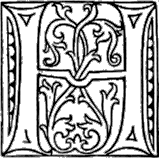 orapollon aus Phaenebythis im ägyptischen Panopolis, griechischer Grammatiker, lebte im 4. Jahrhundert unter Theodosius I. Laut Suidas verfaßte er Kommentare zu Sophokles, Alcaeus und Homer sowie ein Werk (Τεμενιϰά) über den Göttern geweihte Orte. Photius (Cod. 279), der ihn sowohl als Dramatiker wie auch Grammatiker bezeichnet, schreibt ihm eine Geschichte der Gründung und Altertümer Alexandrias zu. Unter dem Namen Horapollon existieren zwei Bücher über Hieroglyphen, die sich als Übersetzung eines ägyptischen Originals ins Griechische durch einen bestimmten Philippus ausgeben, von dem nichts weiter bekannt ist. Das minderwertige Griechisch dieser Übersetzung und der Charakter der Ergänzungen innerhalb des zweiten Buches weisen auf ein spätes Datum hin; von manchen wurde es sogar dem 15. Jahrhundert zugeordnet. Obwohl ein sehr großer Teil der Aussagen absurd erscheint und nicht durch irgendetwas erklärt werden kann, das durch spätere Verwendung bekannt ist, gibt es in beiden Büchern einige Beweise dafür, daß die Tradition der Werte von Hieroglyphenzeichen in der Zeit ihres Autors noch nicht ausgestorben war.
orapollon aus Phaenebythis im ägyptischen Panopolis, griechischer Grammatiker, lebte im 4. Jahrhundert unter Theodosius I. Laut Suidas verfaßte er Kommentare zu Sophokles, Alcaeus und Homer sowie ein Werk (Τεμενιϰά) über den Göttern geweihte Orte. Photius (Cod. 279), der ihn sowohl als Dramatiker wie auch Grammatiker bezeichnet, schreibt ihm eine Geschichte der Gründung und Altertümer Alexandrias zu. Unter dem Namen Horapollon existieren zwei Bücher über Hieroglyphen, die sich als Übersetzung eines ägyptischen Originals ins Griechische durch einen bestimmten Philippus ausgeben, von dem nichts weiter bekannt ist. Das minderwertige Griechisch dieser Übersetzung und der Charakter der Ergänzungen innerhalb des zweiten Buches weisen auf ein spätes Datum hin; von manchen wurde es sogar dem 15. Jahrhundert zugeordnet. Obwohl ein sehr großer Teil der Aussagen absurd erscheint und nicht durch irgendetwas erklärt werden kann, das durch spätere Verwendung bekannt ist, gibt es in beiden Büchern einige Beweise dafür, daß die Tradition der Werte von Hieroglyphenzeichen in der Zeit ihres Autors noch nicht ausgestorben war.
Perhaps the clearest case of such infiltration is that of the hieroglyphs. The history of the supposed Egyptian hieroglyphs of Horapollo, of the rage for them in the Renaissance, and of their development into the emblem, one of the most characteristic of Renaissance phenomena, is the aspect of Renaissance Egyptology which has been the most fully studied and explored. The Hieroglyphica of Horapollo was another of these supposedly ancient but really Hellenistic works; it explains the Egyptian hieroglyph as being a symbol with hidden moral and religious meanings, of course a misunderstanding of its true nature. The hieroglyph fashion is an offshoot of prisca theologia, for it owed much of its vogue to the deep respect for Egyptian wisdom as exemplified in Hermes Trismegistus. In the argumentum before his Pimander, Ficino attributes the invention of the hieroglyph to Hermes. As compared with the talisman, the hieroglyph is not magical. It is a deep way of stating hidden truths in the sacred Egyptian writing. And it was immensely popular with the humanists, and therefore an example of ‘Egyptian’ infiltration into humanism.
— Francis A. Yates: Giordano Bruno and the Hermetic Tradition. Chicago: UP, 1964. pp. 163-164.
Lynn Thorndike
 n seeking a third text and author of the same type as Aelian and Solinus to round out the present chapter, our choice unhesitatingly falls upon the Hieroglyphics of Horapolio, a work which pretends to explain the meaning of the written symbols employed by the ancient Egyptian priests, but which is really principally concerned with the same marvelous habits and properties of animals of which Aelian treated. In brief the idea is that these characteristics of animals must be known in order to comprehend the significance of the animal figures in the ancient hieroglyphic writing. Horapollo is supposed to have written in the Egyptian language in perhaps the fourth or fifth century of our era,[1] but his work is extant only in the Greek translation of it made by a Philip who lived a century or two later and who seems to have made some additions of his own.[2]
n seeking a third text and author of the same type as Aelian and Solinus to round out the present chapter, our choice unhesitatingly falls upon the Hieroglyphics of Horapolio, a work which pretends to explain the meaning of the written symbols employed by the ancient Egyptian priests, but which is really principally concerned with the same marvelous habits and properties of animals of which Aelian treated. In brief the idea is that these characteristics of animals must be known in order to comprehend the significance of the animal figures in the ancient hieroglyphic writing. Horapollo is supposed to have written in the Egyptian language in perhaps the fourth or fifth century of our era,[1] but his work is extant only in the Greek translation of it made by a Philip who lived a century or two later and who seems to have made some additions of his own.[2]
The zoology of Horapollo is for the most part not novel, but repeats the same erroneous notions that may be found in Aristotle’s History of Animals, Pliny’s Natural History, Aelian, and other ancient authors. Again we hear of the basilisk’s fatal breath, of the beaver’s discarded testicles, of the unnatural methods of conception of the weasel and viper, of the bear’s licking its cubs into shape, of the kindness of storks to their parents, of wasps generated from a dead horse, of the phoenix, of the swan’s song, of the sick lion’s eating an ape to cure himself, of the bull tamed by tying it to the branch of a wild fig tree, of the elephant’s fear of a ram or a dog and how it buries its tusks.[3] Less familiar perhaps are the assertions that the mare miscarries, if she merely treads on a wolf’s tracks;[4] that the pigeon cures itself by placing laurel in its nest;[5] that putting the wings of a bat on an ant-hill will prevent the ants from coming out.[6] The statement that if the hyena, when hunted, turns to the right, it will slay its pursuer, while if it turns to the left, it will be slain by him, is also found in Pliny.[7] But his long enumeration of virtues ascribed to parts of the hyena by the Magi does not include the assertion in Horapollo’s next chapter[8] that a man girded with a hyena skin can pass through the ranks of his enemies without injury, although it ascribes somewhat similar virtues to the animal’s skin. In Horapollo it is the hawk rather than the eagle which surpasses other winged creatures in its ability to gaze at the sun; hence physicians use the hawk-weed in eye-cures.[9]
Animals also serve as astronomical or astrological symbols in the system of hieroglyphic writing as interpreted by Horapollo. Not only does a palm tree represent the year because it puts forth a new branch every new moon[10] but the phoenix denotes the magnus annus in the course of which the heavenly bodies complete their revolutions.[11] The scarab rolls his ball of dung from east to west and gives it the shape of the universe.[12] He buries it for twenty-eight days conformably to the course of the moon through the zodiac, but he has thirty toes to correspond to the days of the month. As there is no female scarab, so there is no male vulture. The female vulture symbolizes the Egyptian year by spending five days in conceiving by the wind, one hundred and twenty in pregnancy, the same period in rearing its young, and the remaining one hundred and twenty days in preparing itself to repeat the process.[13] The vulture also visits battlefields seven days in advance and by the direction of its glance indicates which army will be defeated.
The cynocephalus, dog-headed ape, or baboon, was mentioned several times by Pliny, but Horapollo gives more specific information concerning it, chiefly of an astrological character. It is born circumcised and is reared in temples in order to learn from it the exact hour of lunar eclipses, at which times it neither sees nor eats, while the female ex genitalibus sanguinem emittit. The cynocephalus represents the inhabitable world which has seventy-two primitive parts, because the animal dies and is buried piecemeal by the priests during a period of as many days, until at the end of the seventy-second day life has entirely departed from the last remnant of its carcass.[14] The cynocephalus not only marks the time of eclipses but at the equinoxes makes water twelve times by day and by night, marking off the hours; hence a figure of it is carved by the Egyptians on their water-clocks.[15] Horapollo associates together the god of the universe and fate and the stars which are five in number, for he believes that five planets carry out the economy of the universe and that they are subject to God’s government.[16]
Horapollo cannot be given high rank either as a zoologist and astronomer, or a philologer and archaeologist; but at least he was no narrow nationalist and had some respect for history. The Egyptians, he says, “denote a man who has never left his own country by a human figure with the head of an ass, because he neither hears any history nor knows of what is going on abroad.”[17]
— Lynn Thorndike: A History of Magic and Experimental Science. I. New York: Columbia UP, 1923. pp. 331-334.
Edgar Wind
 t follows that Ficino’s praise of the Hieroglyphica of Horapollo, however interesting as a scholium to Plotinus (loc. cit., Opera, p. 1768), gives only an incomplete account of their Renaissance use. It is noticeable, for example, that while Plotinus had stressed the implicit understanding of hieroglyphs, and Ficino had praised them for their power of contracting many thoughts into one single form, those who designed ‘authentic hieroglyphs’ after classical monuments were particularly attracted by the reverse possibility, that of expanding the symbols into an additive picture-script, whose parts were to be read like words and sentences of a discursive language; cf. Hülsen, Le ilustrazioni della ‘Hypnerotomachia Polifili’ e le antichita di Roma, Bibliofila XII (1910), pp. 172 f. figs. 22 f.; L. Volkmann, Bilderschriften der Renaissance (1923), p. 16, fig. 5. The Hypnerotomachia carried that method to extremes by translating Latin sentences, word by word, into hieroglyphic designs which, contrary to Ficino’s argument, consisted always of several symbols, never of one alone. Even the famous compound of anchor and dolphin for festina tarde was not left to itself, but juxtaposed to a circle, for semper, so as to produce a discursive sequence: ‘semper festina tarde’.
t follows that Ficino’s praise of the Hieroglyphica of Horapollo, however interesting as a scholium to Plotinus (loc. cit., Opera, p. 1768), gives only an incomplete account of their Renaissance use. It is noticeable, for example, that while Plotinus had stressed the implicit understanding of hieroglyphs, and Ficino had praised them for their power of contracting many thoughts into one single form, those who designed ‘authentic hieroglyphs’ after classical monuments were particularly attracted by the reverse possibility, that of expanding the symbols into an additive picture-script, whose parts were to be read like words and sentences of a discursive language; cf. Hülsen, Le ilustrazioni della ‘Hypnerotomachia Polifili’ e le antichita di Roma, Bibliofila XII (1910), pp. 172 f. figs. 22 f.; L. Volkmann, Bilderschriften der Renaissance (1923), p. 16, fig. 5. The Hypnerotomachia carried that method to extremes by translating Latin sentences, word by word, into hieroglyphic designs which, contrary to Ficino’s argument, consisted always of several symbols, never of one alone. Even the famous compound of anchor and dolphin for festina tarde was not left to itself, but juxtaposed to a circle, for semper, so as to produce a discursive sequence: ‘semper festina tarde’.
— Edgar Wind: Pagan Mysteries in the Renaissance. New and enlarged edition. London: Faber and Faber, 1968. p. 208.

